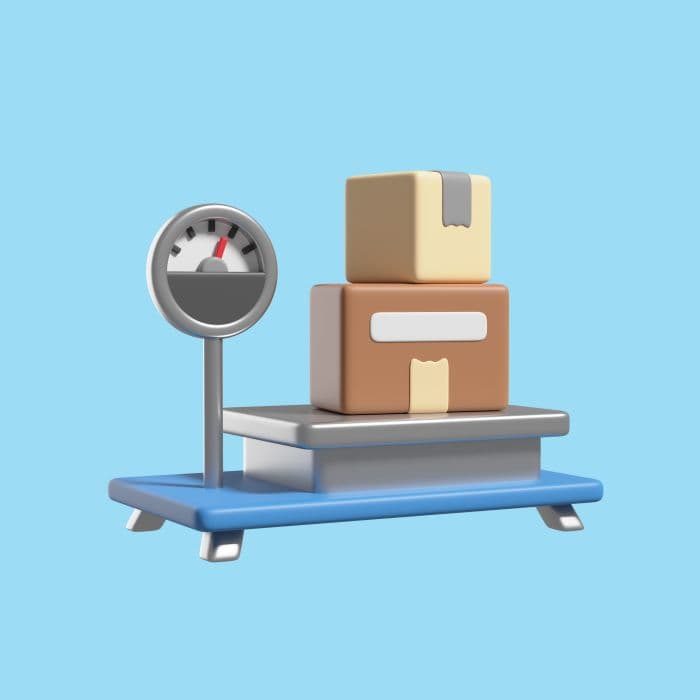When you prepare a shipment, one detail quietly determines your rates, packaging decisions, and even which carrier ends up being the best fit. That detail is weight, and understanding net weight v gross weight helps you calculate accurate shipping costs, avoid billing surprises, and stay compliant with carrier rules.
Even experienced logistics teams can mix the two up, especially when multiple materials and layers of packaging are involved. While the difference may seem simple, it affects transportation costs, inventory management, and carrier selection. This guide explains the difference between gross weight and net weight, how each one is calculated, and why they matter for shipping. You’ll also see how the Airpals Multi-Carrier Platform and the AI Shipping Assistant help simplify these calculations and streamline label creation.
Table of Contents:
- What Does Net Weight Mean?
- What is the Meaning of Gross Weight?
- Net and Gross Weight: The Real Difference Explained
- Let AI Do the Math: Meet the Airpals Shipping Assistant
- Key Takeaways
- Conclusion: Simplify Shipping Decisions with Airpals
- Frequently Asked Questions (FAQs)
What Does Net Weight Mean?
In shipping, net weight refers to the weight of the product alone. It does not include packaging, containers, cushioning, or additional materials. The net weight definition is essential for correctly classifying products, planning inventory, and tracking production.
You’ll often find net weight on packaging for consumer goods, since it represents the exact amount of product being sold. Understanding net and gross weight starts here: net weight isolates just the contents.
Calculate Net Weight: Formulas and Examples
To calculate net weight, subtract packaging weight from the total shipment weight. Formula: Net Weight = Gross Weight – Packaging Weight
Example 1: Consumer Packaged Goods
- Gross weight: 2.5 lb
- Packaging: 0.4 lb
- Net Weight = 2.1 lb
Example 2: Electronics
- Gross weight: 4 lb
- Packaging: 1 lb
- Net Weight = 3 lb
Example 3: Apparel
- Gross weight: 9 oz
- Mailer + label: 1 oz
- Net Weight = 8 oz
These examples show the practical distinction between net versus gross weight and how teams rely on both values to prepare accurate shipment documentation.
What Is the Meaning of Gross Weight?
Gross weight is the total weight of the shipment, including the product, packaging, cushioning, boxes, pallets, and any additional materials. The meaning of gross weight matters because carriers charge based on the total load they transport, and customs agencies use it to calculate duties and verify declarations.
Calculate Gross Weight: Formulas and Examples
Formula: Gross Weight = Product Weight + Packaging Weight
Example 1: Simple Packaging
- Product: 1.5 lb
- Packaging: 0.5 lb
- Gross Weight = 2 lb
Example 2: Fragile Item
- Product: 4 lb
- Primary and secondary boxes: 2.2 lb
- Cushioning and labels: 0.3 lb
- Gross Weight = 6.5 lb
Example 3: Large Items
- Product + box: 22 lb
- Pallet + wrapping: 13 lb
- Gross Weight = 35 lb
Because carriers bill based on the total load, the gross weight of a package often becomes the final measurement used for rating.
Net and Gross Weight: The Real Difference Explained
The difference between net and gross weight comes down to purpose. Net weight defines the product itself. Gross weight defines what the carrier transports.
Net weight supports labeling, production, and inventory. Gross weight drives logistics, cost calculation, and compliance.
How Net and Gross Weight Affect Shipping Costs, Duties, and Compliance
- Rate Calculation: Carriers charge based on the higher value between gross and dimensional weight.
- Customs Requirements: Net weight classifies the product, while gross weight verifies the total mass shipped.
- Packaging Decisions: Extra packaging increases gross weight, affecting cost.
- Safety Standards: Heavy shipments require proper lifting and stacking protocols that depend on gross weight.
- Documentation Accuracy: Incorrect numbers may cause delays, inspections, or additional fees.
How UPS, USPS, and FedEx Handle Weight Differently
- UPS: In the case of UPS, the way they calculate is by comparing actual weight and dimensional weight. A 4 lb product in a 14x14x10 box may bill as 12 lb.
- USPS: Ideal for items under 1 lb. Gross weight determines eligibility for First-Class and Priority Mail. Think of it as the best way to send small packages or letters, where the weight will not really be an issue.)
- FedEx: Applies strict dimensional rules and minimum billable weights, so it’s a really smart move to visit them personally to assess your situation, or to take a look at this cool guide we created for you.
Each carrier uses different thresholds and formulas, making accurate weight measurement essential.
Let AI Do the Math: Meet the Airpals Shipping Assistant
Estimating package weight can be challenging, especially when packaging varies or a scale isn’t available. The Airpals AI Shipping Assistant helps estimate package weight based on item type, packaging, and materials. It connects directly to the Multi-Carrier Platform so you can:
- Get instant rate suggestions
- Compare UPS, USPS, and FedEx from one dashboard
- Create accurate labels
- Avoid manual errors
- Centralize shipments and addresses
No worries if you need to take measurements at home, this easy-to-follow guide will show you exactly how to do it. Understanding net weight v gross weight becomes far easier when AI assists with the estimate.
Key Takeaways
- Net weight refers to the product only.
- Gross weight includes packaging and materials.
- Carriers rely on gross weight for billing.
- Both net and gross weight influence costs, duties, and compliance.
- The Airpals Multi-Carrier Platform centralizes label creation and rate comparison.
- The AI Shipping Assistant helps estimate weight when you don’t know it exactly.
Final Thoughts: Simplify Shipping Decisions with Airpals
Precise weight measurement doesn’t need to be complicated. With a clear understanding of net weight v gross weight, your team can prevent unnecessary charges, optimize packaging, and choose the best carrier every time.
Let the AI Shipping Assistant estimate your next shipment’s weight and manage all carriers from one dashboard. If you ever need help choosing the best option for your shipments, the Airpals team is always happy to support you.

Frequently Asked Questions (FAQs)
What is the net weight?
Net weight is the weight of the product alone, excluding packaging or additional materials. It appears on many types of packaging and is used to classify goods accurately. Understanding net weight helps teams manage inventory, prepare documentation correctly, and distinguish product mass from the total shipped load.
Does net weight include packaging?
No. Net weight only refers to the product itself and excludes all packaging materials. Boxes, wraps, fillers, labels, and pallets are not part of net weight. These materials count toward gross weight instead, which carriers use to determine rates, handling requirements, and overall transportation costs.
How to calculate net weight?
To calculate net weight, subtract packaging weight from the total measured shipment weight. Use the formula: Net Weight = Gross Weight – Packaging Weight. This gives the product’s actual mass and ensures accurate documentation for customs, inventory control, and cost planning when preparing shipments for carriers.
What is the difference between net and gross weight?
Net weight refers to the product alone, while gross weight includes both the product and all packaging materials. Carriers use gross weight to calculate shipping fees, while net weight is mainly used for product classification, labeling, inventory tracking, and customs declarations.
What does gross weight mean?
Gross weight is the total weight of a shipment, including the product, packaging, protective materials, and any additional components. Carriers and customs agencies use this measurement to assess handling requirements, determine shipping costs, verify declarations, and ensure safe transport throughout the entire delivery process.
What is the gross weight of a package?
The gross weight of a package includes everything being shipped: the product, packaging layers, fillers, labels, and protective materials. This is the final measurement carriers rely on for billing and transportation decisions. It determines rates and ensures proper handling throughout the shipping journey.




